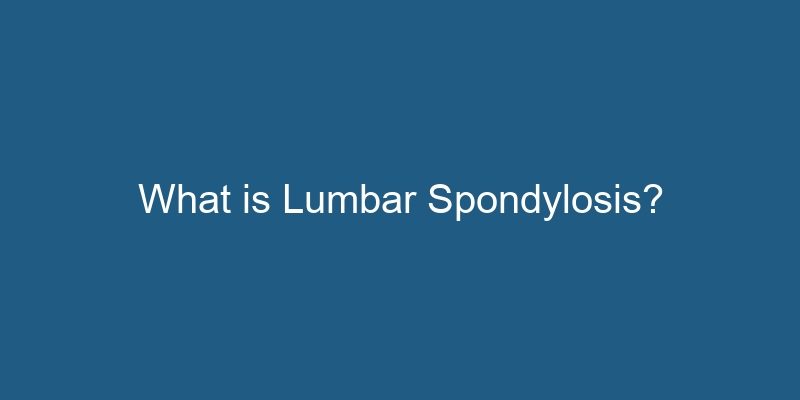Lumbar spondylosis, also known as lumbar osteoarthritis, is a degenerative condition that affects the lower back. It is characterized by the breakdown of the intervertebral discs, the formation of bone spurs, and the thickening of the ligaments in the lumbar region of the spine. This condition is commonly associated with aging and wear and tear on the spine, although it can also be caused by other factors such as trauma or genetic predisposition.
- Symptoms of Lumbar Spondylosis
- Causes of Lumbar Spondylosis
- 1. Aging
- 2. Wear and Tear
- 3. Trauma
- 4. Genetic Predisposition
- Lumbar Spondylosis Reasons
- Degenerative Disc Disease (Spondylosis) explained by Spine Surgeon Dr. Jessica Shellock Plano, TX
- Diagnosis of Lumbar Spondylosis
- Treatment Options for Lumbar Spondylosis
- 1. Medications
- 2. Physical Therapy
- 3. Lifestyle Modifications
- 4. Assistive Devices
- 5. Injections
- 6. Surgery
- Prevention of Lumbar Spondylosis
- 1. Maintain a Healthy Weight
- 2. Practice Proper Body Mechanics
- 3. Exercise Regularly
- 4. Avoid Prolonged Sitting
- 5. Practice Good Posture
- In Conclusion
Symptoms of Lumbar Spondylosis
The symptoms of lumbar spondylosis can vary from person to person, but they generally include:
- Low back pain
- Stiffness and reduced range of motion in the lower back
- Radiating pain or numbness in the legs (sciatica)
- Weakness in the legs
- Muscle spasms
The severity of these symptoms can also vary, ranging from mild discomfort to debilitating pain that affects daily activities.
Causes of Lumbar Spondylosis
There are several factors that can contribute to the development of lumbar spondylosis:
1. Aging
As we age, the intervertebral discs in the spine naturally degenerate and lose their elasticity. This can lead to the breakdown of the discs and the development of bone spurs.
2. Wear and Tear
Repeated stress and strain on the spine, such as lifting heavy objects or engaging in activities that involve repetitive movements, can accelerate the degenerative process in the lumbar region.
3. Trauma
Injury to the spine, such as a fall or a car accident, can damage the intervertebral discs and cause instability in the lumbar region. This can increase the risk of developing lumbar spondylosis.
4. Genetic Predisposition
Some individuals may have a genetic predisposition to developing lumbar spondylosis. Certain genes can affect the strength and integrity of the intervertebral discs, making them more susceptible to degeneration.
Lumbar Spondylosis Reasons
Degenerative Disc Disease (Spondylosis) explained by Spine Surgeon Dr. Jessica Shellock Plano, TX
Diagnosis of Lumbar Spondylosis
To diagnose lumbar spondylosis, a healthcare professional will typically perform a comprehensive physical examination and review the patient’s medical history. Imaging tests, such as X-rays, CT scans, or MRIs, may also be ordered to assess the condition of the spine and rule out other possible causes of the symptoms.
Treatment Options for Lumbar Spondylosis
The treatment of lumbar spondylosis aims to relieve pain, improve mobility, and prevent further degeneration of the spine. The specific treatment plan will depend on the severity of the symptoms and may include:
1. Medications
Nonsteroidal anti-inflammatory drugs (NSAIDs) may be prescribed to reduce pain and inflammation. Muscle relaxants can also be used to alleviate muscle spasms.
2. Physical Therapy
A physical therapist can provide exercises and stretches to improve flexibility, strengthen the muscles supporting the spine, and correct posture. They may also use modalities such as heat or cold therapy to alleviate pain and promote healing.
3. Lifestyle Modifications
Adopting healthy habits, such as maintaining a proper posture, avoiding heavy lifting, and engaging in regular low-impact exercises, can help manage symptoms and prevent further degeneration of the spine.
4. Assistive Devices
In some cases, assistive devices such as back braces or orthotics may be recommended to provide support to the spine and alleviate pain.
5. Injections
Corticosteroid injections can be administered directly into the affected area to reduce inflammation and provide temporary pain relief.
6. Surgery
Surgery is usually considered as a last resort when conservative treatments fail to provide relief. Surgical options may include laminectomy, discectomy, or spinal fusion, depending on the specific needs of the patient.
Prevention of Lumbar Spondylosis
While lumbar spondylosis is often a natural part of the aging process, there are steps that can be taken to reduce the risk of developing this condition:
1. Maintain a Healthy Weight
Excess weight puts additional stress on the spine, accelerating degeneration. Maintaining a healthy weight can help prevent lumbar spondylosis.
2. Practice Proper Body Mechanics
When lifting heavy objects, it is important to use proper lifting techniques and avoid twisting motions that can strain the lower back.
3. Exercise Regularly
Engaging in regular physical activity, such as walking, swimming, or yoga, can help strengthen the muscles supporting the spine and improve overall spinal health.
4. Avoid Prolonged Sitting
Sitting for long periods can put pressure on the intervertebral discs. Taking breaks and incorporating regular movement into daily routines can help reduce the risk of lumbar spondylosis.
5. Practice Good Posture
Maintaining proper posture while sitting, standing, and walking can help distribute weight evenly along the spine and reduce the risk of spinal degeneration.
In Conclusion
Lumbar spondylosis is a degenerative condition that affects the lower back. It can cause pain, stiffness, and reduced mobility. While it is often associated with aging, other factors such as trauma or genetic predisposition can also contribute to its development. Early diagnosis and appropriate treatment can help manage symptoms and prevent further degeneration of the spine. By adopting healthy habits and practicing preventive measures, individuals can reduce the risk of developing lumbar spondylosis and maintain a healthy spine.










